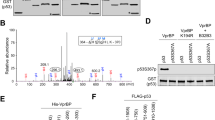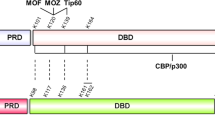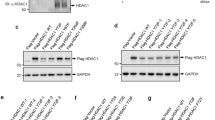Abstract
Acetylation is thought to be a key event for p53 activation. We demonstrate that p14ARF-induced senescence of human mammary epithelial cells (MEC) is associated with p53 acetylation and requires hAda3, a component of histone acetyltransferase complexes and a p53 transcriptional coactivator. Expression of the N-terminal domain of hAda3 that binds p53 but not p300 blocked p14ARF-induced p53 acetylation and protected MECs from senescence. Consistent with these findings, the human papillomavirus 16 E6 mutant Y54D, which selectively targets hAda3 but not p53 for degradation and protects MECs from p14ARF-induced senescence, inhibited p53 acetylation. In H1299 cells, hAda3 overexpression increased p300-mediated p53 acetylation, which conversely decreased following small interfering RNA (siRNA) knockdown of hAda3. Moreover, depletion of hAda3 by siRNA inhibited endogenous p53 acetylation and accumulation of p21cip1 in response to ectopic p14ARF. These studies reveal that, in addition to its known ability to inhibit Mdm2-mediated p53 degradation, p14ARF signals through hAda3 to stimulate p53 acetylation and the induction of cell senescence.
This is a preview of subscription content, access via your institution
Access options
Subscribe to this journal
Receive 50 print issues and online access
$259.00 per year
only $5.18 per issue
Buy this article
- Purchase on Springer Link
- Instant access to full article PDF
Prices may be subject to local taxes which are calculated during checkout






Similar content being viewed by others
References
Appella E . (2001). Modulation of p53 function in cellular regulation. Eur J Biochem 268: 2763.
Balasubramanian R, Pray-Grant MG, Selleck W, Grant PA, Tan S . (2002). Role of the Ada2 and Ada3 transcriptional coactivators in histone acetylation. J Biol Chem 277: 7989–7995.
Band V, Zajchowski D, Kulesa V, Sager R . (1990). Human papilloma virus DNAs immortalize normal human mammary epithelial cells and reduce their growth factor requirements. Proc Natl Acad Sci USA 87: 463–467.
Espinosa JM, Emerson BM . (2001). Transcriptional regulation by p53 through intrinsic DNA/chromatin binding and site-directed cofactor recruitment. Mol Cell 8: 57–69.
Fang L, Igarashi M, Leung J, Sugrue MM, Lee SW, Aaronson SA . (1999). p21Waf1/Cip1/Sdi1 induces permanent growth arrest with markers of replicative senescence in human tumor cells lacking functional p53. Oncogene 18: 2789–2797.
Grant PA, Duggan L, Cote J, Roberts SM, Brownell JE, Candau R et al. (1997). Yeast Gcn5 functions in two multisubunit complexes to acetylate nucleosomal histones: characterization of an Ada complex and the SAGA (Spt/Ada) complex. Genes Dev 11: 1640–1650.
Gu W, Roeder RG . (1997). Activation of p53 sequence-specific DNA binding by acetylation of the p53 C-terminal domain. Cell 90: 595–606.
Ito A, Lai CH, Zhao X, Saito S, Hamilton MH, Appella Ee et al. (2001). p300/CBP-mediated p53 acetylation is commonly induced by p53-activating agents and inhibited by MDM2. EMBO J 20: 1331–1340.
Jin Y, Lee H, Zeng SX, Dai MS, Lu H . (2003). MDM2 promotes p21waf1/cip1 proteasomal turnover independently of ubiquitylation. EMBO J 22: 6365–6377.
Klingelhutz AJ, Foster SA, McDougall JK . (1996). Telomerase activation by the E6 gene product of human papillomavirus type 16. Nature 380: 79–82.
Kumar A, Zhao Y, Meng G, Zeng M, Srinivasan S, Delmolino LM et al. (2002). Human papillomavirus oncoprotein E6 inactivates the transcriptional coactivator human ADA3. Mol Cell Biol 22: 5801–5812.
Lee BY, Han JA, Im JS, Morrone A, Johung K, Goodwin EC et al. (2006). Senescence-associated beta-galactosidase is lysosomal beta-galactosidase. Aging Cell 5: 187–195.
Liu L, Scolnick DM, Trievel RC, Zhang HB, Marmorstein R, Halazonetis TD et al. (1999a). p53 sites acetylated in vitro by PCAF and p300 are acetylated in vivo in response to DNA damage. Mol Cell Biol 19: 1202–1209.
Liu Y, Chen JJ, Gao Q, Dalal S, Hong Y, Mansur CP et al. (1999b). Multiple functions of human papillomavirus type 16 E6 contribute to the immortalization of mammary epithelial cells. J Virol 73: 7297–7307.
Luo J, Nikolaev AY, Imai S, Chen D, Su F, Shiloh A et al. (2001). Negative control of p53 by Sir2alpha promotes cell survival under stress. Cell 107: 137–148.
Michael D, Oren M . (2003). The p53-Mdm2 module and the ubiquitin system. Semin Cancer Biol 13: 49–58.
Nag A, Germaniuk-Kurowska A, Dimri M, Sassack M, Gurumurthy CB, Gao Q et al. (2007). An essential role of human ADA3 in p53 acetylation. J Biol Chem 282: 8812–8820.
Ogryzko VV, Kotani T, Zhang X, Schiltz RL, Howard T, Yang XJ et al. (1998). Histone-like TAFs within the PCAF histone acetylase complex. Cell 94: 35–44.
Patel D, Huang SM, Baglia LA, McCance DJ . (1999). The E6 protein of human papillomavirus type 16 binds to and inhibits co-activation by CBP and p300. EMBO J 18: 5061–5072.
Pearson M, Carbone R, Sebastiani C, Cioce M, Fagioli M, Saito S et al. (2000). PML regulates p53 acetylation and premature senescence induced by oncogenic Ras. Nature 406: 207–210.
Pedeux R, Sengupta S, Shen JC, Demidov ON, Saito S, Onogi H et al. (2005). ING2 regulates the onset of replicative senescence by induction of p300-dependent p53 acetylation. Mol Cell Biol 25: 6639–6648.
Sakaguchi K, Herrera JE, Saito S, Miki T, Bustin M, Vassilev A et al. (1998). DNA damage activates p53 through a phosphorylation-acetylation cascade. Genes Dev 12: 2831–2841.
Serrano M, Lin AW, McCurrach ME, Beach D, Lowe SW . (1997). Oncogenic ras provokes premature cell senescence associated with accumulation of p53 and p16INK4a. Cell 88: 593–602.
Shamanin VA, Androphy EJ . (2004). Immortalization of human mammary epithelial cells is associated with inactivation of the p14ARF-p53 pathway. Mol Cell Biol 24: 2144–2152.
Sherr CJ . (2006). Divorcing ARF and p53: an unsettled case. Nat Rev Cancer 6: 663–673.
Sugrue MM, Shin DY, Lee SW, Aaronson SA . (1997). Wild-type p53 triggers a rapid senescence program in human tumor cells lacking functional p53. Proc Natl Acad Sci USA 94: 9648–9653.
Thomas MC, Chiang CM . (2005). E6 oncoprotein represses p53-dependent gene activation via inhibition of protein acetylation independently of inducing p53 degradation. Mol Cell 17: 251–264.
Vousden KH . (2002). Switching from life to death: the Miz-ing link between Myc and p53. Cancer Cell 2: 351–352.
Wang T, Kobayashi T, Takimoto R, Denes AE, Snyder EL, el-Deiry WS et al. (2001). hADA3 is required for p53 activity. EMBO J 20: 6404–6413.
Wang X, Taplick J, Geva N, Oren M . (2004). Inhibition of p53 degradation by Mdm2 acetylation. FEBS Lett 561: 195–201.
Wei W, Hemmer RM, Sedivy JM . (2001). Role of p14(ARF) in replicative and induced senescence of human fibroblasts. Mol Cell Biol 21: 6748–6757.
Zhang Z, Wang H, Li M, Agrawal S, Chen X, Zhang R . (2004). MDM2 is a negative regulator of p21WAF1/CIP1, independent of p53. J Biol Chem 279: 16000–16006.
Zimmermann H, Degenkolbe R, Bernard HU, O'Connor MJ . (1999). The human papillomavirus type 16 E6 oncoprotein can down-regulate p53 activity by targeting the transcriptional coactivator CBP/p300. J Virol 73: 6209–6219.
Acknowledgements
We thank Rainer Brachmann and Steven Grossman for generously providing plasmids, Yuval Nitzan for help with computer graphics, Jason Chen and Samisubbu Naidu for review of the manuscript. We appreciate the assistance of Ting Yu with confocal microscopy. This work was supported by NIH grant R01CA107394.
Author information
Authors and Affiliations
Corresponding author
Additional information
Addendum
While this manuscript was under review, another study reported the role of hADA3 in DNA damage-induced acetylation and stabilization of the p53 protein (Nag et al., 2007).
Supplementary Information accompanies the paper on the Oncogene website (http://www.nature.com/onc).
Supplementary information
Rights and permissions
About this article
Cite this article
Sekaric, P., Shamanin, V., Luo, J. et al. hAda3 regulates p14ARF-induced p53 acetylation and senescence. Oncogene 26, 6261–6268 (2007). https://doi.org/10.1038/sj.onc.1210462
Received:
Revised:
Accepted:
Published:
Issue Date:
DOI: https://doi.org/10.1038/sj.onc.1210462
Keywords
This article is cited by
-
Identification of novel interaction between Promyelocytic Leukemia protein and human Alteration/Deficiency in Activation 3 coactivator and its role in DNA damage response
Journal of Proteins and Proteomics (2019)
-
CREB-binding protein plays key roles in juvenile hormone action in the red flour beetle, Tribolium Castaneum
Scientific Reports (2018)
-
Genes conserved in bilaterians but jointly lost with Myc during nematode evolution are enriched in cell proliferation and cell migration functions
Development Genes and Evolution (2015)
-
Critical pathways in cellular senescence and immortalization revealed by gene expression profiling
Oncogene (2008)



